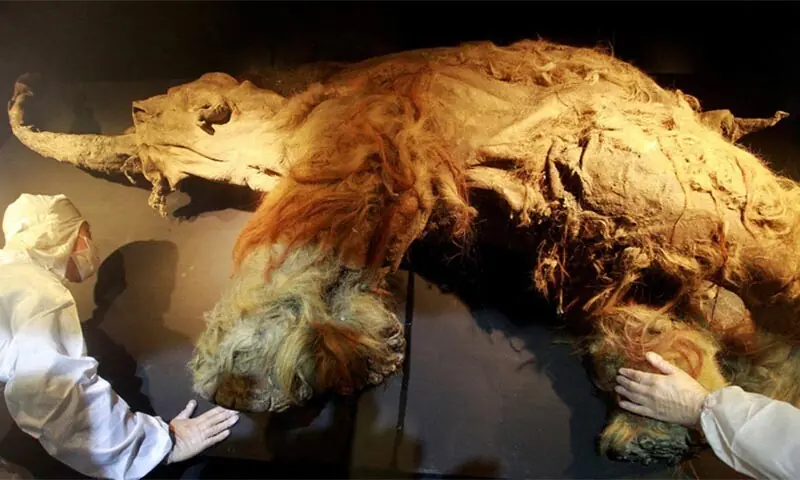Scientists have recovered the oldest known RNA, a molecule necessary for most biological functions, from a woolly mammoth that inhabited Siberia about 39,000 years ago, showing that it may last longer than previously known and promising a new avenue for studying organisms that lived long ago.
The RNA, successfully isolated and sequenced, was extracted from the muscle tissue of the left foreleg of a juvenile male mammoth, between five and ten years old, whose carcass was discovered in 2010 in the Siberian permafrost in the Russian Far East, along the Oyogos Yar coast, which borders the Laptev Sea.
The mammoth, called Yuka, represents one of the best preserved frozen corpses of this extinct species. Their RNA, among other things, revealed which genes had been “turned on” in Yuka’s tissue at the time of her death, showing signs of cellular stress.
Most knowledge about prehistoric organisms comes from the study of skeletal fossils, but there is a limit to what these can reveal about their biology. However, the growing ability to recover telltale biomolecules from ancient remains has offered new ways to understand such organisms.
The new RNA achievement complements advances in recent years in the study of ancient DNA, the molecule that carries genetic instructions for all living organisms, and ancient proteins, the molecules that build and operate much of the cellular machinery.
RNA, short for ribonucleic acid, serves as a message sent from an organism’s genome to its cellular machinery, telling cells which genes to turn on or off, how and when to regulate their function, and what proteins to produce.
“With RNA, you can access the real biology of the cell or tissue that occurs in real time in the last moments of the organism’s life,” said Emilio Mrmol, a geneticist, veterinarian and bioinformatician at the Globe Institute at the University of Copenhagen, lead author of the study published Friday in the journal Cell.
“This gives us direct access to the functional landscape of the cellular metabolism of woolly mammoths when they were alive, something that is not possible, at least not to the extent we report, simply using DNA or proteins. Adding this layer of information provides a more complete view of woolly mammoth biology,” Mrmol said.
RNA is more fragile than DNA and proteins. The oldest DNA recovered to date comes from animals, plants and microbes dating back about 2 million years in Greenland sediments. The oldest proteins come from the dental remains of a hornless rhinoceros that lived about 23 million years ago in the Canadian High Arctic.
Until now, the oldest RNA recovered came from a wolf pup that lived in Siberia about 14,000 years ago.
“I think the key finding is that we can recover RNA from such an ancient sample. It’s a proof of principle that opens the door to much more detailed analyzes of gene expression patterns in Ice Age megafauna,” said geneticist and study co-author Love Daln of Stockholm University and the Swedish Center for Paleogenetics.
Yuka experienced trauma before she died, with deep cuts in her skin indicating an attack by a cave lion, an extinct species that was a bulkier, cold-adapted cousin of today’s African lion.
“None of the marks are serious enough to have caused death, so it is still unclear why Yuka died,” Daln said.
The researchers detected RNA molecules in Yuka that encode proteins involved in muscle contraction and metabolic regulation under stress, possibly, but not necessarily, derived from this attack.
Scientists have long thought that RNA degrades just minutes or hours after death, but this study and others showed that, under the right circumstances, it can survive much longer. The frigid conditions of Siberia were particularly conducive to the preservation of RNA.
Yuka’s DNA has also been sequenced previously by these researchers and others. Previously thought to be female, but genetic data showed that Yuka, who stood about 5-1/4 feet (1.6 meters) at the shoulder, was male, with an X and Y chromosome.
The researchers believe that, under the right conditions, RNA can be recovered from even older remains, and they note that ancient RNA offers numerous possibilities.
“We hope that our work will spark renewed interest in exploring RNA in other ancient remains, not necessarily from the Ice Age or extinct species, but also from medieval or historical remains of extinct and extant organisms,” Mrmol said.








